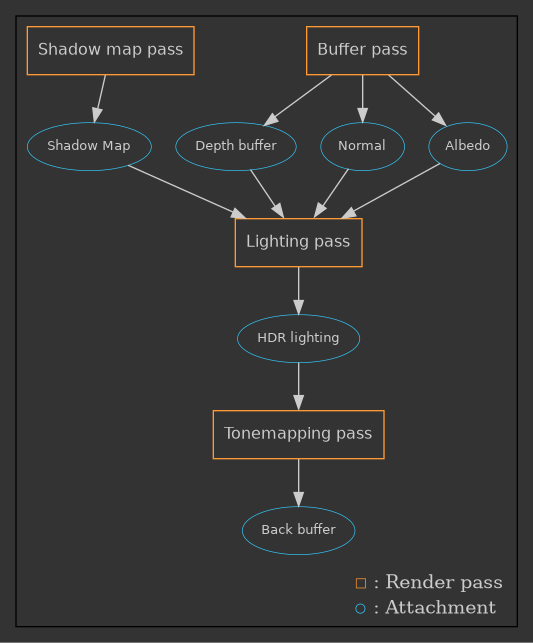Linuxviewer API
Window.h
#pragma once
#include <vulkan/SynchronousWindow.h>
class Window : public vulkan::task::SynchronousWindow
{
public:
using vulkan::task::SynchronousWindow::SynchronousWindow;
Also the Window class is using the same constructors as the base class.
private:
// Define render_pass / attachment objects.
RenderPass main_pass{this, "main_pass"};
The HelloTriangle application only uses a single render pass.
A Render Graph is a directed acyclic graph that can be used to specify the dependency of render passes. It is a convenient way to manage the rendering especially when using a low level API such as Vulkan.

How to create a more complicated render graph using linuxviewer will be documented later.
// We have two shaders. One for the vertex stage and one for the fragment stage of the pipeline.
// Initialized by register_shader_templates.
friend class TrianglePipelineCharacteristic;
vulkan::shader_builder::ShaderIndex m_shader_vert;
vulkan::shader_builder::ShaderIndex m_shader_frag;
The Window stores handles/indices to the two shader templates
(see Window.cxx
for their definition).
// The pipeline factory that will create our graphics pipeline.
vulkan::pipeline::FactoryHandle m_pipeline_factory;
// The graphics pipeline.
vulkan::Pipeline m_graphics_pipeline;
The final two ingredients: the pipeline factory that will create the pipeline that we need,
and the object that represents that pipeline itself. And yes, that means that m_graphics_pipeline
is incomplete and not usable until the pipeline factory finished creating it. At the moment this
is polled by testing if m_graphics_pipeline.handle() is non-NULL. The part of linuxviewer that
will deal with this in a clean way hasn’t been implemented yet.
private:
//---------------------------------------------------------------------------
// Override virtual functions of the base class.
void create_render_graph() override;
void register_shader_templates() override;
void create_graphics_pipelines() override;
void render_frame() override;
// We're not using textures or vertex buffers.
void create_textures() override { }
void create_vertex_buffers() override { }
Each Window class must override several virtual functions of the base class.
All of the above six functions are pure virtual and therefore must be implemented
by the user derived Window class: there is no default.
However, because we are not using textures or vertex buffers, the latter two can remain empty.
//---------------------------------------------------------------------------
// Called by render_frame.
void draw_frame();
Just a private function, called from render_frame. We could have put that code
inside the overridden render_frame function too.
